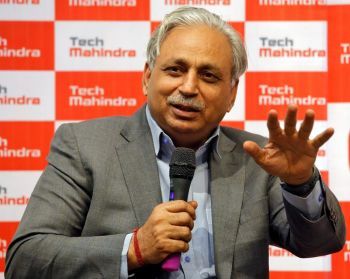 | « Back to article | Print this article |
The top companies with a striking gap in pay between the senior-most executives and median employees in 2017-2018 belonged mostly to sectors such as information technology, auto and engineering, discovers Sachin P Mampatta.

A top executive earns as much as Rs 3,150.69 for every rupee earned by a median employee, when the gap between the two is at its highest.
And this is not a one-off.
Among listed companies, at least seven top executives earn more than a 1,000 times the compensation of their median employees.
The median employee falls in the middle of the compensation hierarchy.
The numbers are based on an analysis of data from corporate-tracker Prime Database (nseinfobase.com).
The top companies with a striking gap in pay between the senior-most executives and median employees in 2017-2018 belonged mostly to sectors such as information technology, auto and engineering.
Stock options and one-time benefits widened the gap in some cases.
For instance, Larsen and Toubro's A M Naik's compensation included retirement benefits.
Tech Mahindra's C P Gurnani had stock options pushing up his remuneration.
"To put it in perspective, the fixed compensation of Tech Mahindra's CEO is at Rs 26 million. CEO's compensation reported in FY18 and for previous years included earnings from exercise of old ESOPS and (are) hence not comparable," said a Tech Mahindra spokesperson.
Other companies, contacted for their comment, did not respond.
The data for the seven top executives during 2017-2018 mentioned earlier in this report has been derived from a universe of 2,851 directors for whom information is available.
In the previous year, there were 17 top executives, recording the widest gap in pay with median employees, out of a total of 5,665 directors.
In 2016-2017, these top executives earned more than 25,685 times the pay of their median employees.
J N Gupta, co-founder and managing director of corporate governance advisory Stakeholder Empowerment Services, said while there are professionals who also get outsized pay-packages; owner-managers especially have disproportionate compensation.
"Largely promoters are the culprit," he said.
Shriram Subramanian, founder and managing director of proxy advisor InGovern Research Services, said changes were unlikely in the near future.
"I don't think it will correct," he said.
Also, there's no woman in the top ten list of remuneration multiples.
This is in line with global research that suggests that the gender pay gap extends right to the very top.
In fact, a March 2015 Federal Reserve Bank of New York staff report Gender and Dynamic Agency: Theory and Evidence on the Compensation of Top Executives noted that women top executives are not rewarded the same way as their male counterparts.
For example, men are rewarded with more than ten times what their female counterparts get for the same increase in firm value, it said.
Women are also more likely to be negatively impacted by bad firm performance.
It's in sync with the income inequality in the country as well.
Lucas Chancel and Thomas Piketty from the Paris School of Economics in their discussion paper Indian Income Inequality, 1922-2014: From British Raj to Billionaire Raj noted that the top one per cent of income earners had 22 per cent share of national income as of 2014, a multi-decade high.
'According to our benchmark estimates, the share of national income accruing to the top 1 per cent income earners is now at its highest level since the creation of the Indian Income Tax in 1922,' Chancel and Piketty pointed out in their October 2017 paper.